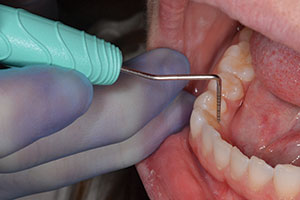Beauty is only skin deep, but function goes to the core! As hygienists, we work to polish, shine, and smooth tooth surfaces, while maintaining a healthy periodontium. In the past, that was all that was required. Today, however, hygienists are expected to understand the functional relationship of teeth and their relationship to comprehensive care.
| Table. Hygiene Occlusal Analysis Steps |
|
Observe and Record Standards and Deviations |
HOW CAN HYGIENISTS HELP?
KEEP HYGIENE SKILLS CURRENT
Hygienists realize that occlusal concepts and diagnostic information were not taught in hygiene school. But, like a hand and glove that fit together, so must hygienists be aware of the occlusion as it relates to restorative and periodontal care. The traditional lack of occlusal focus during hygiene assessment and treatment planning all too often supports random crown recommendations or amalgam placement. These “hunt and discover” protocols can lead to destructive consequences, such as fractured restorations, increased occlusal pathology, tooth sensitivity, and/or periodontal breakdown.
- the multiple factors, signs, and symptoms associated with occlusion and TMD.
- how untreated poor occlusion negatively affects the longevity of restorative material.
- correcting occlusal discrepancies to decrease the progression of periodontal disease, localized recession, bone loss, and bulbous tissue.
- occlusal considerations in aesthetic dentistry.
HOW DO WE START?
HYGIENE OCCLUSAL SCREENING
A hygienist’s scope of service is to engage the patient in questions that reveal possible symptoms and recognition of basic clinical signs. Below are examples of questions to consider during routine hygiene screening:
- Have you noticed your teeth getting shorter, longer, or chipping easily?
- Do you or have you ever had difficulty when you chew or eat?
- Are you aware of any grinding or clenching of your teeth?
- Do you or have you ever had problems with your jaw or had any injury to your jaw or face area?
- Are you aware of or ever had any pain/discomfort when you chew, talk, open too wide, or close?
- Do you hear or have you ever heard grating, clicks, pops?
- Does your jaw ever stick or lock?
One of the most easily recognized, and often overlooked, symptoms of malocclusion is cervical notches on the facial surfaces of the teeth. These areas have been categorized as abfraction, abrasion, erosion, attrition, and even gingival recession. In the traditional hygiene mode, we often inform our patients suffering from these lesions that they had caused the situation by scrubbing too hard or using a hard-bristled toothbrush. Research now tells us that these noncarious lesions have a multifactorial etiology. For instance, abrasion lesions can be caused by a combination of user pressure, toothbrush stiffness, toothpaste, and/or occlusal discrepancies. Signs of erosion (gradual, nonbacterial demineralization that occurs in enamel) can be the result of high dietary acids, decreased salivary flow, unstable pH levels, and occlusal discrepancies.
PERIO AND OCCLUSION
Have you ever noted clinically a “spare tire” of tissue around a tooth and significant gingival recession? The patient swears to effective plaque control, and as a clinician you cannot discover the cause, nor manage it. Occlusion key: in December 1999, the American Academy of Periodontology (www.perio.org) released a position paper entitled, “Development of Classification System for Periodontal Disease and Conditions,” which identified risk factors for periodontal pathosis. Etiologies that have been linked to periodontal disease include: host response to specific bacteria, smoking, systemic disease, age, past disease, gender, nutritional deficiencies, tooth anatomy, restorative work, and primary and secondary occlusal trauma. Current research findings discuss the association between untreated occlusal irregularities and the progression of periodontal disease. Effective occlusal treatment can reduce the progression of periodontal disease over time, and occlusal evaluation is an integral part of periodontal treatment plans.
HOW IS IT DONE?
HYGIENE DIAGNOSTIC AIDS
Until recently, the diagnostic tools available to clinicians, eg, articulating paper, were not sensitive enough to accurately depict what was wrong with a patient’s bite. About 5 years ago, an emerging technology called T-Scan (TekScan) began to aid the clinician in accurately developing a well-balanced occlusal treatment plan. The system works by having a patient bite on a sensor, which feeds data to a computer software program. The T-Scan then uses vivid 3-D graphics to show the results that can be viewed by the clinician and patient. This technology also includes a video component that allows hygienists to measure the biting forces over time.
PARTNERS IN PATIENT CARE: HYGIENIST AS OCCLUSION CO-THERAPIST
Hygienists have been unknowingly viewing occlusal dysfunction signs and clinical systems since hygiene school. But now they can identify their relevance and link them with innovative management options. Modes of treatment could range from simple adjustments and occlusal splint therapy to orthodontics, orthognathic surgery, or full-mouth rehabilitation. Occlusal equilibration can be an efficient and effective modality for occlusal dysfunction, especially aided by the newer technologies, ie, T-Scan.
CONCLUSION
If during your next clinical screening you discover a tooth or sextant showing characteristics of periodontal infection, take a closer look at the occlusal forces. The diseased area may also be experiencing secondary occlusal trauma.
Ms. Hodsdon is a coach with Hygiene Mastery, author of a collaborative book, Demystifying Smiles: Strategies for the Dental Team, an international speaker, and developer of the Pre-D Systems software. She is a frequent contributor to dental industry publications including RDH Magazine, Journal of Practical Hygiene, Dental Economics, and the Journal of Cosmetic Dentistry. Ms. Hodsdon is a member of the ADHA and the AACD, and has served on New Hampshire’s state dental regulatory board. She continues to serve on a variety of industry advisory boards and panels. Ms. Hodsdon can be reached at (888) 347-4785, or e-mail kahodsdon@pre-d.com or kristine@hygienemastery.com.
Ms. Mitchell is a full-time practicing hygienist for Dr. Michael Koczarski in Woodinville, Wash. She is a coach with Hygiene Mastery and codirects the hygiene program for PAC~live. Ms. Mitchell lectures and instructs extensively on the comprehensive assessment of dental wants and needs, treatment planning, and codiagnosis of anterior and posterior aesthetic dentistry. She can be contacted at (425) 486-2200.











